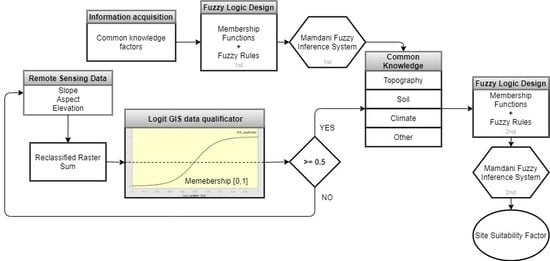The Use of Common Knowledge in Fuzzy Logic Approach for Vineyard Site Selection
Abstract
:1. Introduction
2. Materials and Methods
2.1. Materials for Spatial Information Acquisition
2.2. Materials for Common Knowledge Acquisition
2.3. Information Acquisition and Membership Functions
2.4. Implementation of Fuzzy Logic-Based System
- Factors—fundamental data, which consists of common knowledge obtained from the literature search. As the aim of this paper states: only the Common and Interchangeable variables were used in further steps;
- Information acquisition—it is the phase of translating acquired data into manageable information in terms of deriving if-then rules, as well as ranges of possibilities;
- Membership functions—a step of applying proper membership functions to different linguistic terms;
- Fuzzy rules—a transformation of acquired information to a set of if-then rules with selected examples of principles used in the process of aggregating results from individual groups:
- (Topography==Bad) & (Soil==Bad) & (Climate==Bad) & (Other==Bad) => (Site_Final_Assessment=Bad_Site) (1)
- (Topography==Good) & (Soil==Bad) & (Climate==Good) & (Other==Good) => (Site_Final_Assessment=Average_Site) (1)
- (Topography==Good) & (Soil==Good) & (Climate==Good) & (Other==Bad) => (Site_Final_Assessment=Average_Site) (1)
- (Topography==Good) & (Soil==Good) & (Climate==Good) & (Other==Good) => (Site_Final_Assessment=Good_Site) (1)
- (Topography==Bad) & (Soil==Good) & (Climate==Good) & (Other==Bad) => (Site_Final_Assessment=Bad_Site) (1)
- Fuzzy inference system—a process of the inference cycle fuzzy matching execution, fuzzy conflict resolution (logical operators strategy), and fuzzy rule-firing when faced with given information;
- User interface—environment for communication between fuzzy decision support system and user. The interface should be as easy to follow as possible.
- Fuzzification of input: resolving of all fuzzy statements in the antecedent to a degree of membership between 0 and 1.
- Application of fuzzy operator to multiple part antecedents: applying fuzzy logic operators to resolve the antecedent to a single number between 0 and 1, which is the degree of support for the rule.
- Application of implication method: using the degree of support for the entire rule to shape the output fuzzy set. The consequence of a fuzzy rule assigns an entire fuzzy set to the output. This fuzzy set is represented by a membership attribute, which is chosen to show the following qualities. If the antecedent was only partially valid (i.e., a value less than one is assigned), then the inference method truncated the output fuzzy set under the chosen implication method (Appendix C).
3. Results
3.1. Graphical Representation of the Developed Fuzzy System
3.2. Aggregated Results
3.3. Assessment Method Simulation
4. Discussion
5. Conclusions
Author Contributions
Funding
Conflicts of Interest
Appendix A

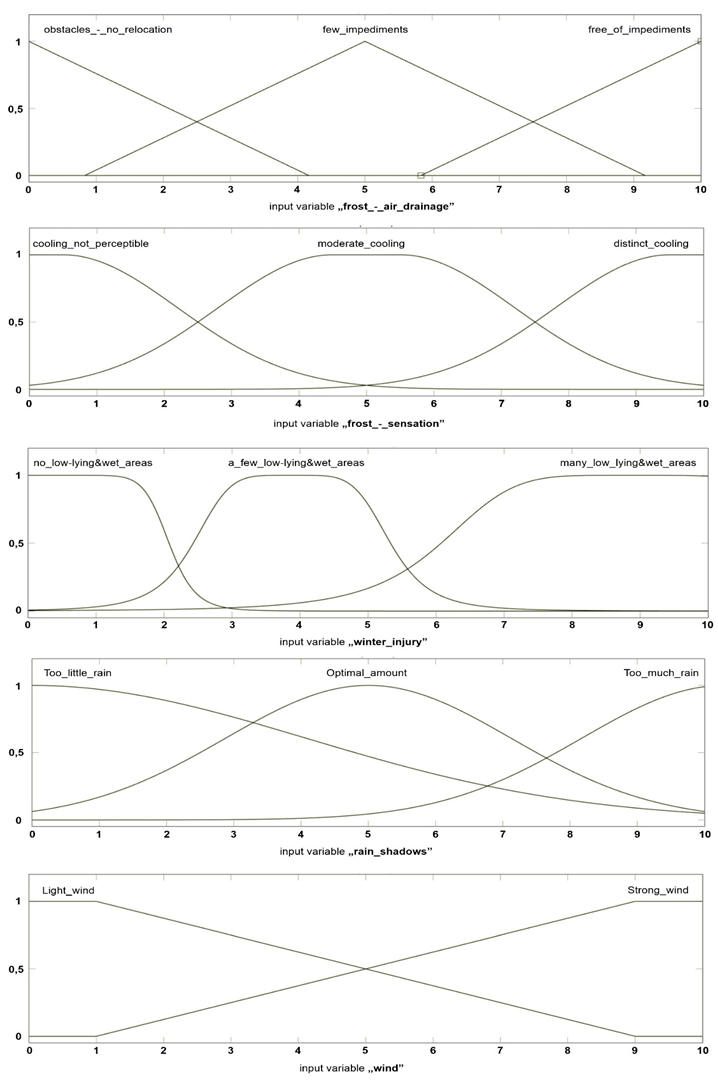
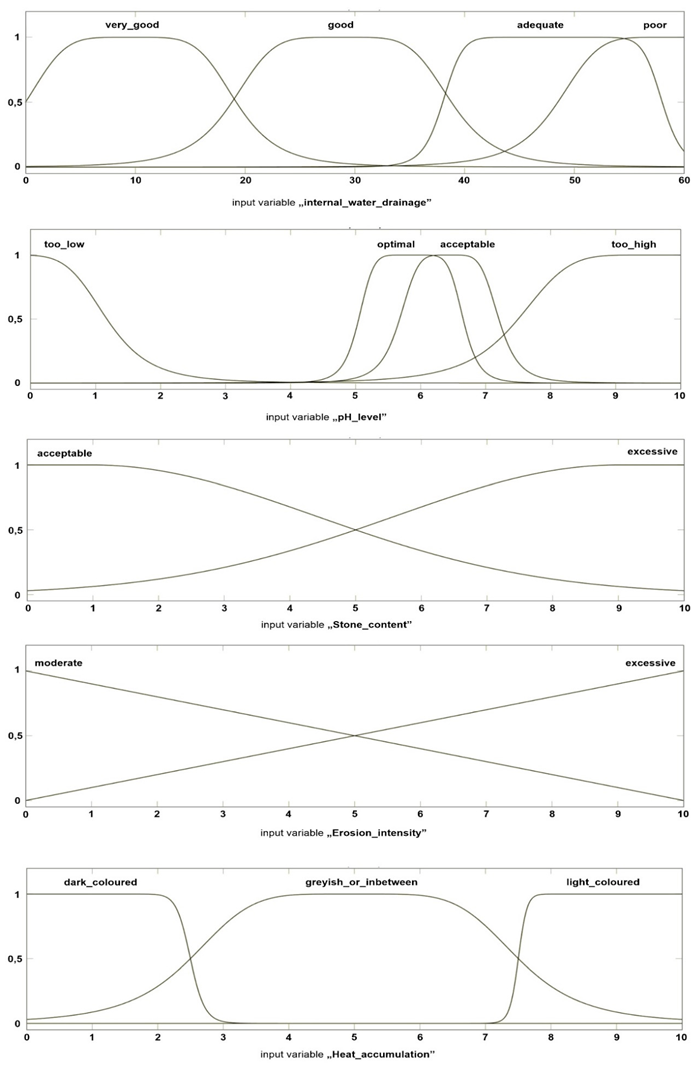
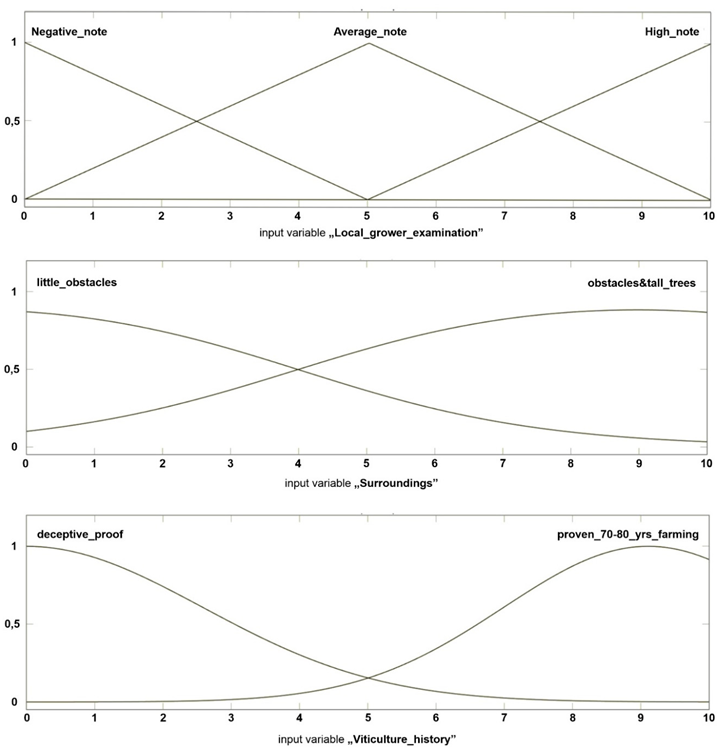
Appendix B
Appendix C
References
- Chen, L.-C.; Kingsbury, A.K. Development of wine industries in the New-New World: Case studies of wine regions in Taiwan and Japan. J. Rural. Stud. 2019, 72, 104–115. [Google Scholar] [CrossRef]
- Priilaid, D.; Ballantyne, R.; Packer, J. A “blue ocean” strategy for developing visitor wine experiences: Unlocking value in the Cape region tourism market. J. Hosp. Tour. Manag. 2020, 43, 91–99. [Google Scholar] [CrossRef]
- Doloreux, D.; Lord-Tarte, E. Context and differentiation: Development of the wine industry in three Canadian regions. Soc. Sci. J. 2012, 49, 519–527. [Google Scholar] [CrossRef]
- Cradock-Henry, N.A.; Fountain, J. Characterising resilience in the wine industry: Insights and evidence from Marlborough, New Zealand. Environ. Sci. Policy 2019, 94, 182–190. [Google Scholar] [CrossRef]
- Festa, G.; Shams, S.M.R.; Metallo, G.; Cuomo, M.T. Opportunities and challenges in the contribution of wine routes to wine tourism in Italy—A stakeholders’ perspective of development. Tour. Manag. Perspect. 2020, 33, 100585. [Google Scholar] [CrossRef]
- Gladstones, J. Viticulture and Environment; Winetitles Adeladie: Broadview, Australia, 1992. [Google Scholar]
- Smith, L. Site Selection for Establishment & Management of Vineyards. In Proceedings of the SIRC 2002—The 14th Annual Colloquium of the Spatial Information Research Centre University of Otago, Dunedin, New Zealand, 3–5 December 2002. [Google Scholar]
- Chien, M. A Practical Guide to Developing a Commercial Wine Vineyard; Pennsylvania State University; Pennsylvania State Cooperative Extension University Park: Scranton, PA, USA, 2013. [Google Scholar]
- Unwin, T. Terroir: At the Heart of Geography; Springer Science and Business Media LLC: Berlin/Heidelberg, Germany, 2011; pp. 37–48. [Google Scholar]
- Jones, G.V.; Snead, N.; Nelson, P. Modeling viticultural landscapes: A GIS analysis of the terroir potential in the Umpqua Valley of Oregon. In Geology and Wine; Geoscience Canada: St. John’s, NL, Canada, 2004; pp. 167–178. [Google Scholar]
- Kurtural, K.S. Vineyard Site Selection; Kentucky, 2007. Available online: https://www.uky.edu/hort/sites/www.uky.edu.hort/files/documents/KF_31_02.pdf (accessed on 20 March 2020).
- Harrison, D.J. Terroir: The role of geology, climate and culture in the making of French wine. Q. J. Eng. Geol. Hydrogeol. 2000, 33, 350. [Google Scholar] [CrossRef]
- Jackson, D. Climate, Monographs in Cool Climate Viticulture–2; Daphne Brasell Associates: Wellington, New Zealand, 2001. [Google Scholar]
- Jackson, D.; Schuster, D. The Production of Grapes and Wines in Cool Climates; Daphne Brasell Associates: Wellington, New Zealand, 1994. [Google Scholar]
- Kurtural, S.K.; Dami, I.E.; Taylor, B.H. Utilizing GIS Technologies in Selection of Suitable Vineyard Sites. Int. J. Fruit Sci. 2007, 6, 87–107. [Google Scholar] [CrossRef]
- Jurisic, M.; Stanisavljevic, A.; Plascak, I. Application of Geographic Information System (GIS) in the selection of vineyard sites in Croatia. Bulg. J. Agric. Sci. 2010, 16, 235–242. [Google Scholar]
- Arnaudova, Z.; Bileva, T. The use of GIS to support sustainable management of vineyards in Plovdiv, Bulgaria. Commun. Agric. Appl. Boil. Sci. 2011, 76, 355–361. [Google Scholar]
- Czernecki, B.; Glogowski, A.; Nowosad, J. Climate: An R Package to Access Free In-Situ Meteorological and Hydrological Datasets For Environmental Assessment. Sustainability 2020, 12, 394. [Google Scholar] [CrossRef] [Green Version]
- Dąbrowska, J.; Dąbek, P.; Lejcuś, I. A GIS based approach for the mitigation of surface runoff to a shallow lowland reservoir. Ecohydrol. Hydrobiol. 2018. [Google Scholar] [CrossRef]
- Szewrański, S.; Kazak, J.K.; Żmuda, R.; Wawer, R. Indicator-Based Assessment for Soil Resource Management in the Wrocław Larger Urban Zone of Poland. Pol. J. Environ. Stud. 2017, 26, 2239–2248. [Google Scholar] [CrossRef] [Green Version]
- Szopińska, E.; Kazak, J.K.; Kempa, O.; Rubaszek, J. Spatial Form of Greenery in Strategic Environmental Management in the Context of Urban Adaptation to Climate Change. Pol. J. Environ. Stud. 2019, 28, 2845–2856. [Google Scholar] [CrossRef]
- Sánchez-Lozano, J.; García-Cascales, M.S.; Lamata, M. Identification and selection of potential sites for onshore wind farms development in Region of Murcia, Spain. Energy 2014, 73, 311–324. [Google Scholar] [CrossRef]
- Allen, A.; Brito, G.; Caetano, P.; Costa, C.; Cummins, V.; Donnelly, J.; Koukoulas, S.; O’Donnell, V.; Robalo, C.; Vendas, D. A Landfill Site Selection Process Incorporating GIS Modelling. In Proceedings of the Sardinia 2003, Ninth International Waste Management and Landfill Symposium, Margherita di Pula, Cagliari, 6–10 October 2003. [Google Scholar]
- Ilie, L.-A.; Comănescu, L.; Dobre, R.; Nedelea, A.; Săvulescu, I.; Bradea, I.A.; Bolos, M.I. Fuzzy Techniques for Artificial Snow Cover Optimization in the Ski Areas. Case Study: Obârșia Lotrului (Southern Carpathians, Romania). Sustainability 2020, 12, 632. [Google Scholar] [CrossRef] [Green Version]
- Samec, P.; Caha, J.; Zapletal, M.; Tuček, P.; Cudlín, P.; Kučera, M. Discrimination between acute and chronic decline of Central European forests using map algebra of the growth condition and forest biomass fuzzy sets: A case study. Sci. Total. Environ. 2017, 599, 899–909. [Google Scholar] [CrossRef]
- Pászto, V.; Brychtová, A.; Tuček, P.; Marek, L.; Burian, J. Using a fuzzy inference system to delimit rural and urban municipalities in the Czech republic in 2010. J. Maps 2014, 11, 231–239. [Google Scholar] [CrossRef]
- Halás, M.; Klapka, P.; Erlebach, M. Unveiling spatial uncertainty: A method to evaluate the fuzzy nature of functional regions. Reg. Stud. 2018, 53, 1029–1041. [Google Scholar] [CrossRef]
- Dheena, P.; Mohanraj, G. Multicriteria decision-making combining fuzzy set theory, ideal and anti-ideal points for location site selection. Expert Syst. Appl. 2011, 38, 13260–13265. [Google Scholar] [CrossRef]
- Agrell, P.J. On redundancy in multi criteria decision making. Eur. J. Oper. Res. 1997, 98, 571–586. [Google Scholar] [CrossRef]
- Dubois, D.; Hüllermeier, E.; Prade, H. Fuzzy methods for case-based recommendation and decision support. J. Intell. Inf. Syst. 2006, 27, 95–115. [Google Scholar] [CrossRef] [Green Version]
- Badr, G.; Hoogenboom, G.; Moyer, M.; Keller, M.; Rupp, R.; Davenport, J. Spatial suitability assessment for vineyard site selection based on fuzzy logic. Precis. Agric. 2018, 19, 1027–1048. [Google Scholar] [CrossRef]
- Olson, D.L. Multi-Criteria Decision Support. In Handbook on Decision Support Systems 1; Springer: Berlin/Heidelberg, Germany, 2008; pp. 299–314. ISBN 978-3-540-48712-8. [Google Scholar]
- Kazak, J.K.; Chruściński, J.; Szewrański, S. The Development of a Novel Decision Support System for the Location of Green Infrastructure for Stormwater Management. Sustainability 2018, 10, 4388. [Google Scholar] [CrossRef] [Green Version]
- Marques, G.; Gourc, D.; Lauras, M. Multi-criteria performance analysis for decision making in project management. Int. J. Proj. Manag. 2011, 29, 1057–1069. [Google Scholar] [CrossRef]
- Yüksel, I. Developing a Multi-Criteria Decision Making Model for PESTEL Analysis. Int. J. Bus. Manag. 2012, 7. [Google Scholar] [CrossRef] [Green Version]
- Kazak, J.K.; Van Hoof, J. Decision support systems for a sustainable management of the indoor and built environment. Indoor Built Environ. 2018, 27, 1303–1306. [Google Scholar] [CrossRef] [Green Version]
- Wang, T.; Han, Q.; De Vries, B. SIRPSS—Sustainable Industrial Site Redevelopment Planning Support System. In Proceedings of the New Information and Communication Technologies for Knowledge Management in Organizations; Springer Science and Business Media LLC: Berlin/Heidelberg, Germany, 2018; pp. 3–14. [Google Scholar]
- Noszczyk, T. A review of approaches to land use changes modeling. Hum. Ecol. Risk Assessment: Int. J. 2018, 25, 1377–1405. [Google Scholar] [CrossRef]
- Dická, J.N.; Gessert, A.; Sninčák, I. Rural and non-rural municipalities in the Slovak Republic. J. Maps 2019, 15, 84–93. [Google Scholar] [CrossRef] [Green Version]
- Mayer, A. Online social networks in economics. Decis. Support Syst. 2009, 47, 169–184. [Google Scholar] [CrossRef]
- Mrówczyńska, M. Neural networks and neuro-fuzzy systems applied to the analysis of selected problems of geodesy. In Computer Assisted Mechanics and Engineering Sciences; Institute of Fundamental Technological Research: Warsaw, Poland, 2011. [Google Scholar]
- Zadeh, L. Fuzzy logic. Scholarpedia 2008, 3, 1766. [Google Scholar] [CrossRef]
- Ross, T.J. Fuzzy Logic with Engineering Applications; John Wiley & Sons, Ltd.: Hoboken, NJ, USA, 2010. [Google Scholar]
- Jamshidi, A.; Yazdani-Chamzini, A.; Siamak, H.Y.; Khaleghi, S. Developing a new fuzzy inference system for pipeline risk assessment. J. Loss Prev. Process. Ind. 2013, 26, 197–208. [Google Scholar] [CrossRef]
- Hüllermeier, E. Fuzzy machine learning and data mininga. Wiley Interdiscip. Rev. Data Min. Knowl. Discov. 2011, 1, 269–283. [Google Scholar] [CrossRef]
- Cheung, W.W.L.; Pitcher, T.J.; Pauly, D. A fuzzy logic expert system to estimate intrinsic extinction vulnerabilities of marine fishes to fishing. Boil. Conserv. 2005, 124, 97–111. [Google Scholar] [CrossRef]
- Fossati, J.P.; Galarza, A.; Martín-Villate, A.; Echeverría, J.M.; Fontan, L. Optimal scheduling of a microgrid with a fuzzy logic controlled storage system. Int. J. Electr. Power Energy Syst. 2015, 68, 61–70. [Google Scholar] [CrossRef]
- Bendib, B.; Krim, F.; Belmili, H.; Almi, M.F.; Boulouma, S. Advanced Fuzzy MPPT Controller for a Stand-alone PV System. Energy Procedia 2014, 50, 383–392. [Google Scholar] [CrossRef] [Green Version]
- Mrówczyńska, M.; Sztubecka, M.; Skiba, M.; Bazan-Krzywoszańska, A.; Bejga, P. The Use of Artificial Intelligence as a Tool Supporting Sustainable Development Local Policy. Sustainability 2019, 11, 4199. [Google Scholar] [CrossRef] [Green Version]
- Mendes, W.; Araújo, F.; Dutta, R.; Heeren, D.M. Fuzzy control system for variable rate irrigation using remote sensing. Expert Syst. Appl. 2019, 124, 13–24. [Google Scholar] [CrossRef]
- Gajić, A.; Krunić, N.; Protić, B. Towards a new methodological framework for the delimitation of rural and urban areas: A case study of Serbia. Geogr. Tidsskr. J. Geogr. 2018, 118, 160–172. [Google Scholar] [CrossRef]
- Coulon-Leroy, C.; Charnomordic, B.; Thiollet-Scholtus, M.; Guillaume, S. Imperfect knowledge and data-based approach to model a complex agronomic feature—Application to vine vigor. Comput. Electron. Agric. 2013, 99, 135–145. [Google Scholar] [CrossRef] [Green Version]
- Carey, V.; Archer, E.; Barbeau, G.; Saayman, D. The use of local knowledge relating to vineyard performance to identify viticultural terroirs in stellenbosch and surrounds. Acta Hortic. 2007, 385–392. [Google Scholar] [CrossRef]
- Romani, M.; Rapi, B.; Conese, C.; Bonora, L.; Dainelli, N. Integrated techniques for vineyard variability evaluation. Acta Hortic. 2007, 379–384. [Google Scholar] [CrossRef]
- Jackson, R.S. Wine Science: Principles, Practice, Perception; Academic Press: Cambridge, MA, USA, 2000. [Google Scholar]
- EEA Digital Elevation Model over Europe. Available online: https://www.eea.europa.eu/data-and-maps/data/eu-dem (accessed on 20 March 2020).
- Dougherty, P.H. The Geography of Wine: Regions, Terroir and Techniques; Springer: Berlin/Heidelberg, Germany, 2012; ISBN 9789400704640. [Google Scholar]
- Hess, M. O mezoklimacie wypukłych i wklęsłych form terenowych w Polsce Południowej. Przegląd Geogr. 1966, 11/19, 23–35. [Google Scholar]
- Wolf, T.K. Site Selection for Commercial Vineyards; Virginia Agriculture Experiment Station: Winchester, VA, USA, 1997. [Google Scholar]
- Molga, M. Meteorologia Rolnicza; Państwowe Wydawnictwo Rolnicze i Leśne: Warszawa, Poland, 1980. [Google Scholar]
- Smart, R.; Robinson, M. Sunlight into wine: A Handbook for Winegrape Canopy Management; Winetitles: New Haven, CT, USA, 1991. [Google Scholar]
- Bosak, W. Winologia. O Winorośli i Winie. Available online: http://www.winologia.pl/teksty_lokalizacja.html (accessed on 20 March 2020).
- Kwapieniowa, M. Początki uprawy winorośli w Polsce. Mater. Archeol. 1959, 1, 353–399. [Google Scholar]
- Unwin, T. Wine and the Vine: An Historical Geography of Viticulture and the Wine Trade; Routledge: Abingdon, UK, 2005; ISBN 9781134761920. [Google Scholar]
- Mamdani, E.; Assilian, S. An experiment in linguistic synthesis with a fuzzy logic controller. Int. J. Man-Mach. Stud. 1975, 7, 1–13. [Google Scholar] [CrossRef]
- Kaur, A.; Kaur, A. Comparison of Mamdani-Type and Sugeno-Type Fuzzy Inference Systems for Air Conditioning System. Int. J. Soft Comput. Eng. 2012, 2, 323–325. [Google Scholar]
- MATLAB Fuzzy Logic Toolbox—MATLAB; MathWorks Inc.: Natick, MA, USA, 2017.
- Bai, Y.; Wang, D. Fundamentals of fuzzy logic control—Fuzzy sets, fuzzy rules and defuzzifications. In Advances in Industrial Control; Springer: London, UK, 2006. [Google Scholar]
- Pradhan, B. Use of GIS-based fuzzy logic relations and its cross application to produce landslide susceptibility maps in three test areas in Malaysia. Environ. Earth Sci. 2010, 63, 329–349. [Google Scholar] [CrossRef]
- Ocalir, E.V.; Ercoskun, O.Y.; Tur, R.; Öcalır, E.V. An integrated model of GIS and fuzzy logic (FMOTS) for location decisions of taxicab stands. Expert Syst. Appl. 2010, 37, 4892–4901. [Google Scholar] [CrossRef]
- Dry, P.R.; Smart, R.E. Vineyard site selection. In Viticulture; Coombe, B.G., Dry, P.R., Eds.; Winetitles: Adelaide, Australia, 1988. [Google Scholar]
- Kiker, G.A.; Bridges, T.S.; Varghese, A.; Seager, T.P.; Linkov, I. Application of Multicriteria Decision Analysis in Environmental Decision Making. Integr. Environ. Assess. Manag. 2005, 1, 95. [Google Scholar] [CrossRef]
- Wilson, J.E. Terroir: The Role of Geology, Climate and Culture in the Making of French Wines; University of California Press: Berkeley, CA, USA, 1998. [Google Scholar]
- Liao, S.-H. Expert system methodologies and applications—A decade review from 1995 to 2004. Expert Syst. Appl. 2005, 28, 93–103. [Google Scholar] [CrossRef]
- Lee, C.-S.; Wang, M.-H. A Fuzzy Expert System for Diabetes Decision Support Application. IEEE Trans. Syst. Man Cybern. Part B (Cybernetics) 2010, 41, 139–153. [Google Scholar] [CrossRef]
- Hong, T.-P.; Lee, C.-Y. Induction of fuzzy rules and membership functions from training examples. Fuzzy Sets Syst. 1996, 84, 33–47. [Google Scholar] [CrossRef]
- Bona, B. Fuzzy controllers. Automatica 2001, 37, 319–321. [Google Scholar] [CrossRef]
- Bellman, R.E.; Zadeh, L.A. Decision-Making in a Fuzzy Environment. Manag. Sci. 1970, 17. [Google Scholar] [CrossRef]
- Marewski, J.N.; Gigerenzer, G. Heuristic decision making in medicine. Dialog- Clin. Neurosci. 2012, 14, 77–89. [Google Scholar]
- Luce, M.F. Consumer Decision Making. In The Wiley Blackwell Handbook of Judgment and Decision Making; John Wiley & Sons: Hoboken, NJ, USA, 2015. [Google Scholar]
- Busemeyer, J.R.; Townsend, J.T. Decision field theory: A dynamic-cognitive approach to decision making in an uncertain environment. Psychol. Rev. 1993, 100, 432. [Google Scholar] [CrossRef]
- Buchanan, B.G.; Bobrow, D.; Davis, R.; McDermott, J.; Shortliffe, E.H. Knowledge-Based Systems. Annu. Rev. Comput. Sci. 1990, 4, 395–416. [Google Scholar] [CrossRef]
- Aggarwal, C.C.; Aggarwal, C.C. Knowledge-Based Recommender Systems. In Recommender Systems; Springer: Cham, Switzerland, 2016. [Google Scholar]
- Cintra, M.; Camargo, H.; Monard, M. Genetic generation of fuzzy systems with rule extraction using formal concept analysis. Inf. Sci. 2016, 349, 199–215. [Google Scholar] [CrossRef]
- Setnes, M. Supervised fuzzy clustering for rule extraction. IEEE Trans. Fuzzy Syst. 2000, 8, 416–424. [Google Scholar] [CrossRef]
- Kainz, W. Fuzzy Logic and GIS; University of Vienna: Vienna, Austria, 2001. [Google Scholar]
- Khurana, A.; Rosenthal, S.R. Integrating the fuzzy front end of new product development. MIT Sloan Manag. Rev. 1997, 38, 103. [Google Scholar]
- Buckley, J.J.; Eslami, E.; Buckley, J.J.; Eslami, E. Fuzzy Optimization. In An Introduction to Fuzzy Logic and Fuzzy Sets; Springer: Berlin/Heidelberg, Germany, 2002. [Google Scholar]
- Zhu, A.X.; Hudson, B.; Burt, J.; Lubich, K.; Simonson, D. Soil Mapping Using GIS, Expert Knowledge, and Fuzzy Logic. Soil Sci. Soc. Am. J. 2001, 65, 1463–1472. [Google Scholar] [CrossRef] [Green Version]
- Cornelis, C.; Lu, J.; Guo, X.; Zhang, G. One-and-only item recommendation with fuzzy logic techniques. Inf. Sci. 2007, 177, 4906–4921. [Google Scholar] [CrossRef]
- Keenan, P.; Jankowski, P. Spatial Decision Support Systems: Three decades on. Decis. Support Syst. 2018. [Google Scholar] [CrossRef]
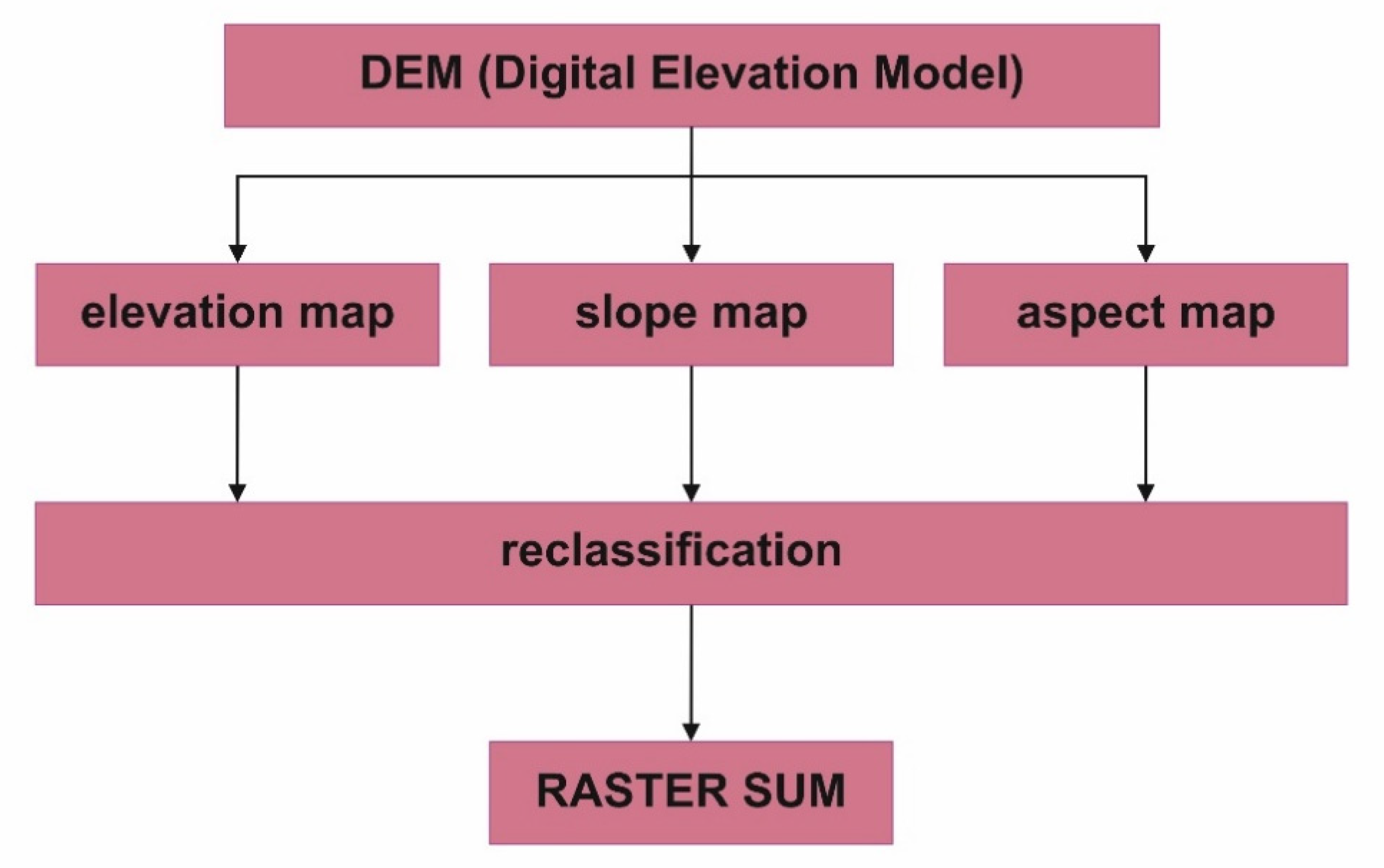
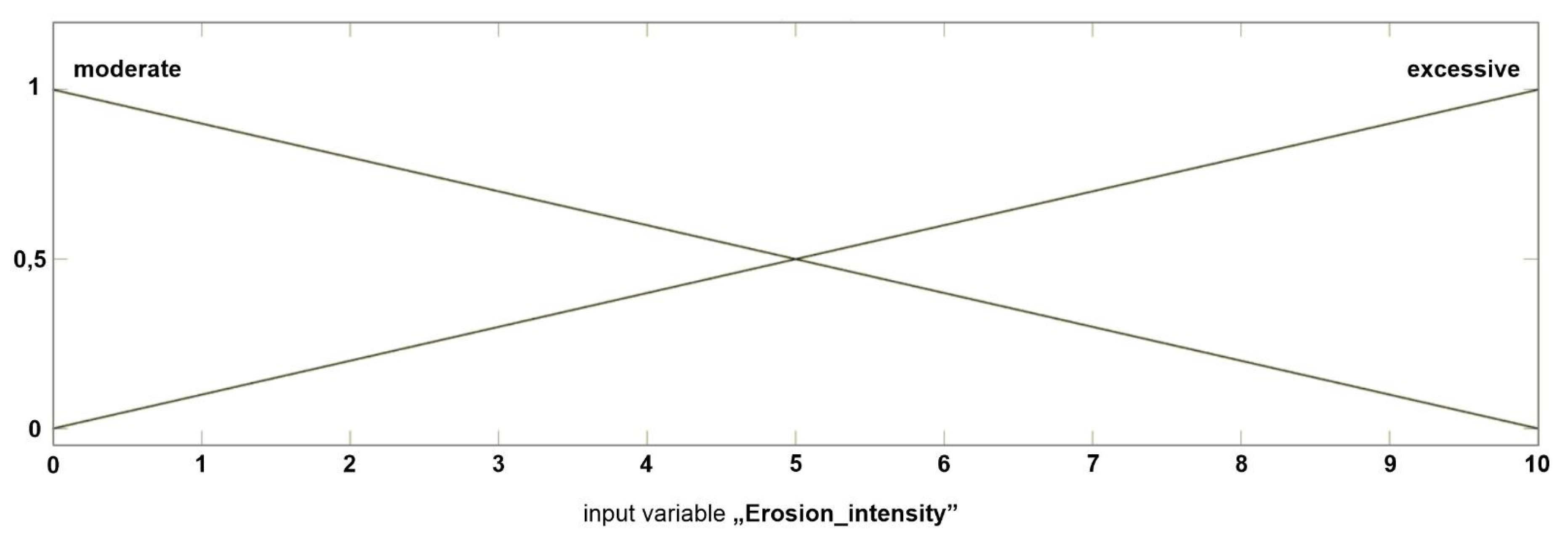
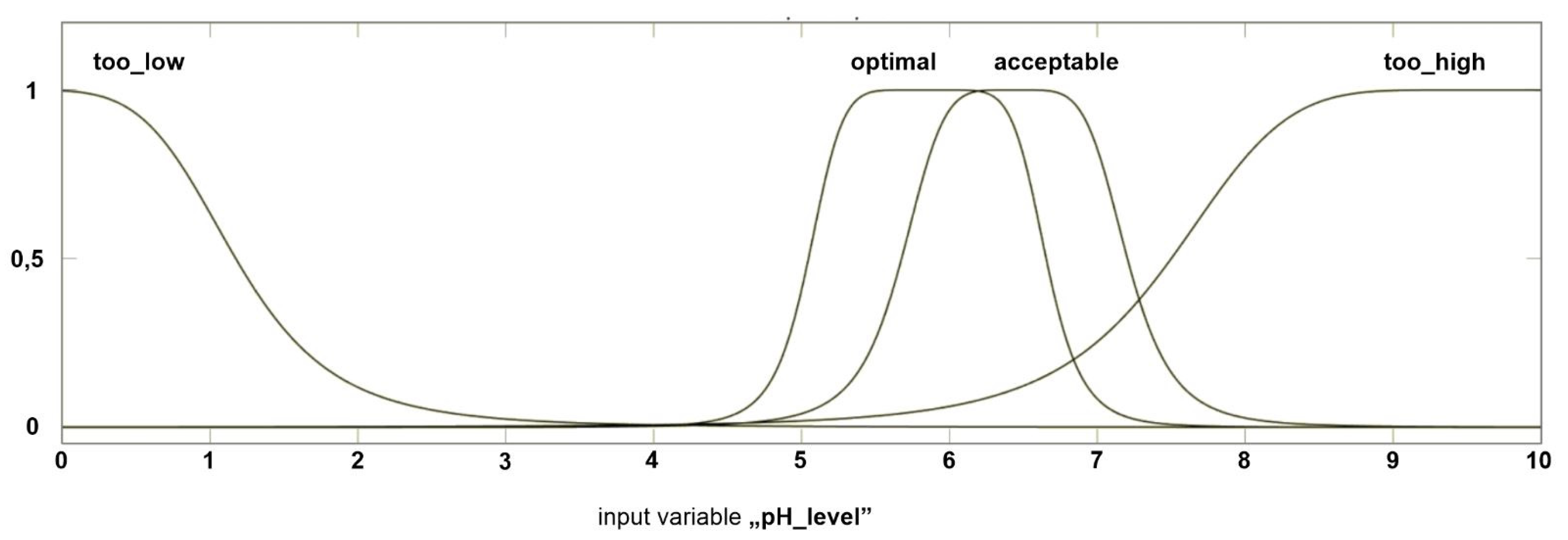
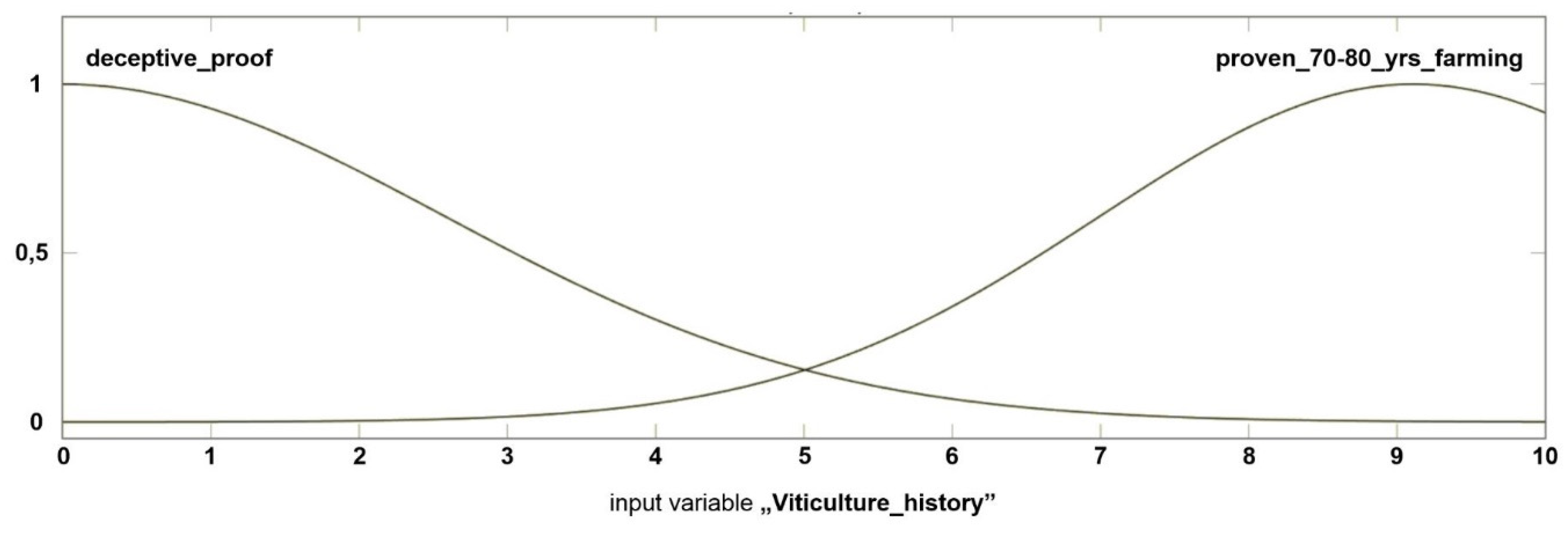
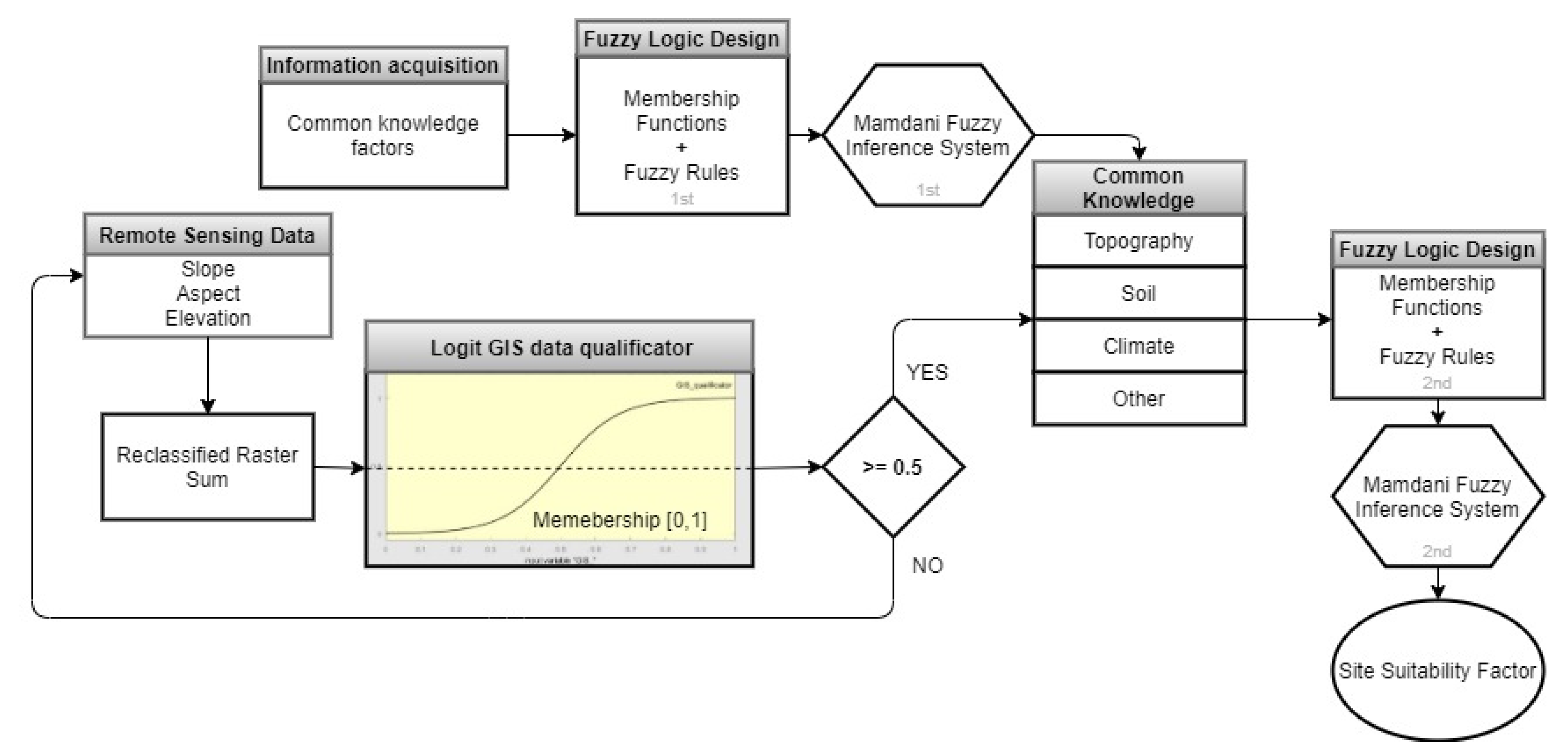

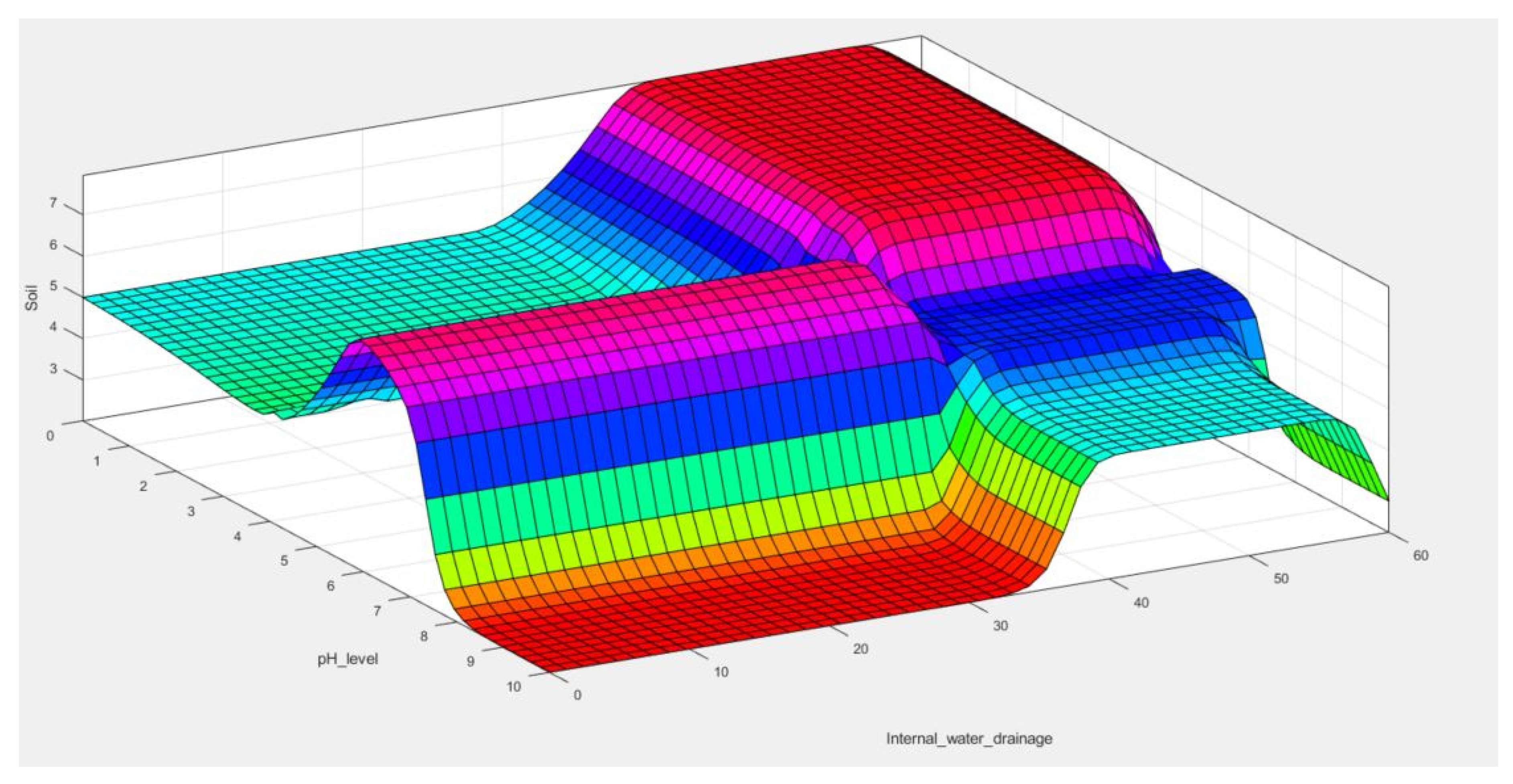
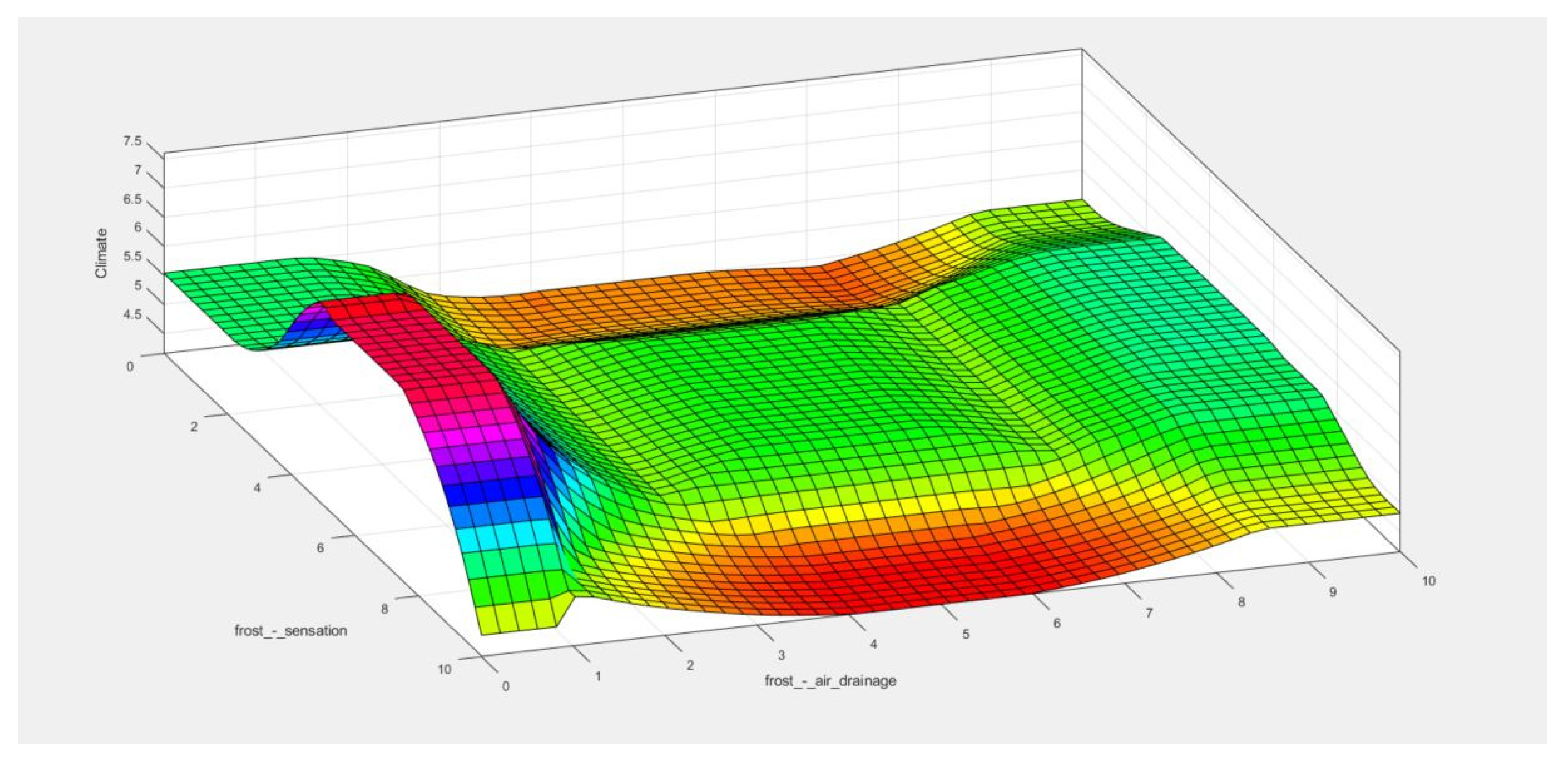
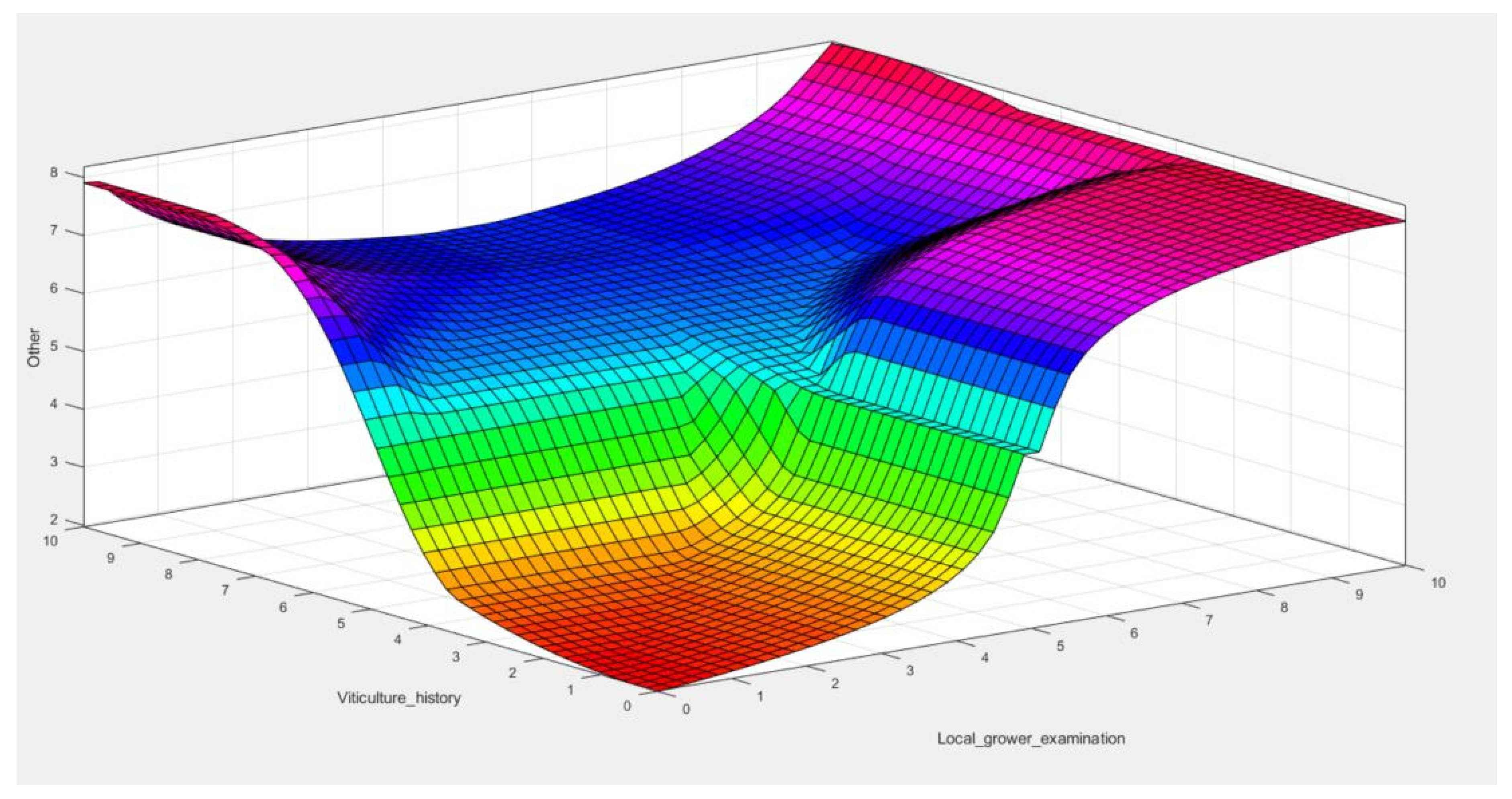
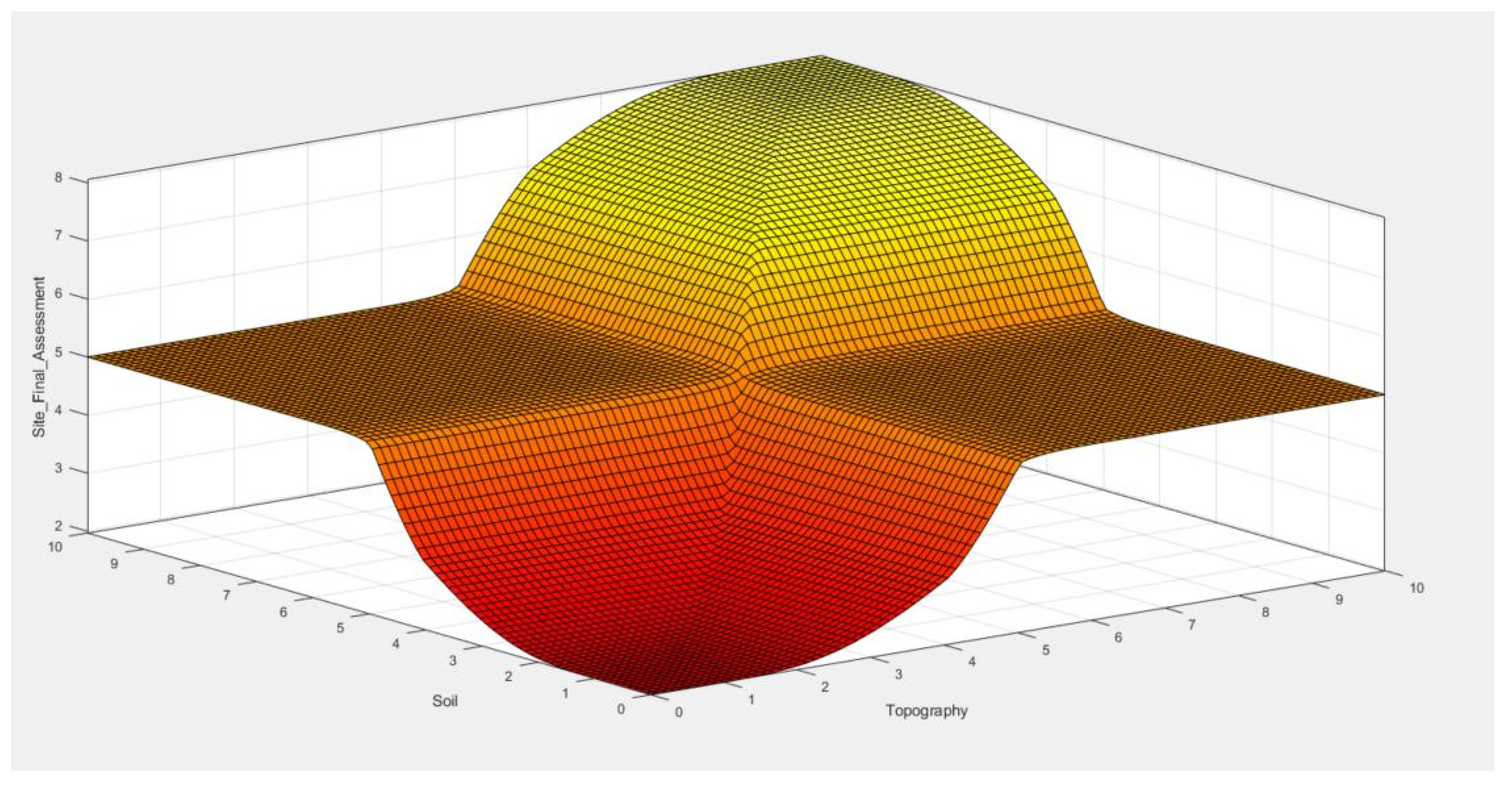
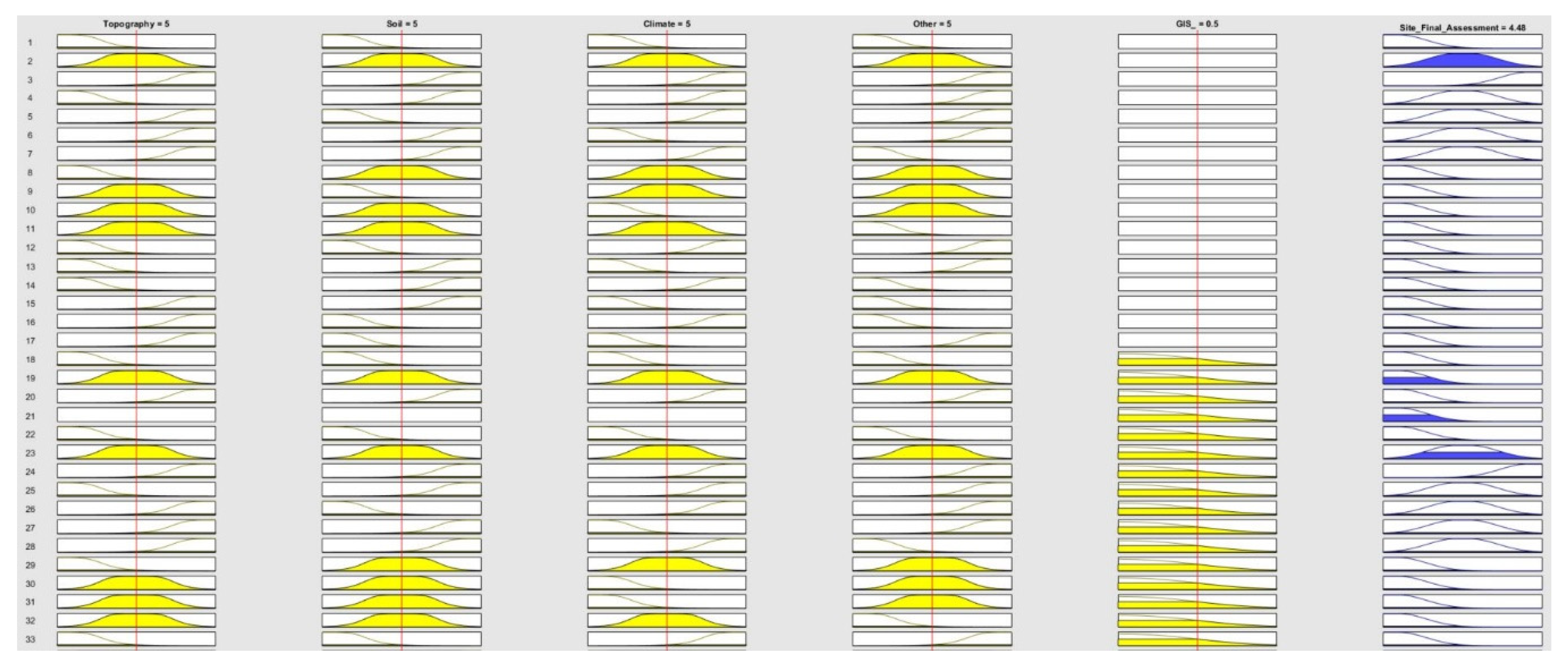
| Factor | Common Knowledge |
|---|---|
| Topography | |
| Elevation | Ask other local growers for a location of a “sweet spot” in absolute and local elevation, which is a zone of earliest ripening with a lower risk of winter injury and frost [8]. |
| River valley | Look for wide river valleys that have positive mezoclimate because of the lower height above the sea than surroundings [6,57]; this positive effect would not appear in small valleys and narrow gorges in which the cold air is accumulated [58,59]. |
| Water reservoir | Look for a site that is not surrounded by shallow lakes, ponds, backwaters, swamps, and wetlands because they have a negative influence on thermal conditions. Their ability of heat accumulation is infinitesimal, and a wide evaporation surface creates a danger of frost appearance. The positive influence can only appear with the big and deep rivers and lakes that are located up to a dozen meters from the site [60]. |
| Soil | |
| Internal water drainage | Walk through a field after heavy rain—if water stands for a day or more after a rain—choose another site [8], or dig a hole two feet deep and feel it with water—if water drains out in 8 h the internal water drainage is excellent, in 24 h: good, in 48 h: adequate, and after 48 h: poor [11]. |
| pH level | Make a test of soil pH—when pH is between 5.5 and 6.5 the site is optimal when it is below 5.5—there might be a problem with phosphorus deficiency and aluminium toxicity; pH up to 7.5 is acceptable, but above 7.5 vines may develop zinc and iron chlorosis deficiency; to influence nutrition uptake pH between 5.0 and 6.0 will be optimal [8]. |
| Stone content | Choose the site that does not have excessive stone content; rocks on or near the surface are not desirable [8]. |
| Erosion intensity | Choose the site that does not have excessive erosion of topsoil [8]. |
| Heat accumulation | Too little heat accumulation can stunt grape ripening, while too much heat shortens the growing season and does not allow for proper development of flavour [8]; the newest research present that sites with light-colored soils (arenaceous or calcareous) can improve the wine quality. This type of soil reflects the light—fruits are better enriched with light, and in their rind, there are more polyphenolic compounds [61]. |
| Climate | |
| Frost | Choose the site where the cold air is drained quickly from the ground; avoid concave land (where the cold air would settle); slopes and vineyard borders without barriers (like buildings or trees) provide good air drainage [8]; the range of frost basin can be determined by observation of spring and autumn hoarfrost (around 6 a.m.) and appearance of half-day and nightly fog [58]; the evening walk in late summer or autumn can also be a valuable experience—when walking down the slope the feeling of chill should appear—below this site the vineyard should not be located [62]. |
| Winter injury | Do not plant grapes in wet, low-lying areas of the site [8]. |
| Rainfall shadows | Too much rain can lead to enormous compaction if the soil is in poor condition, and also more insects may appear; analyze the distribution of rain using climate data services or talking to winegrowers to find “rain shadows”—areas that receive less rain than their surroundings [8]. |
| Wind | Choose the places that are relatively secluded and shielded from north and west; light wind (2–3 m/s) has a positive influence on the health of vine by hampering the growth of fungal diseases; the heavy wind has a negative influence on the microclimate of the vineyard [62]. |
| Other | |
| Local winegrower examination | Walk the site with local winegrower who can examine the whole property with the knowledge of local conditions. |
| Surroundings | Observe the surrounding of the site—trees, buildings, hills, and other barriers that interrupt the vineyard, especially from south and west are not desirable [8,62]. |
| History of viticulture at the site | The historical localization of vineyards can be the proof of good site, but only if these vineyards had economic value and survived for 70–80 years; the localizations of small garden vineyards are not good factors, while they were often planted as a decoration and not for economic reasons [63]; it is also important to notice that in the past, vineyard districts were stated based on trade area localization and not always connected with the terroir of the site [64]. |
| Variable | Type of Membership Function | Range | No. of Functions |
|---|---|---|---|
| Topography | |||
| Elevation | Pi-shaped | 0–10 | 3 |
| River valley | Generalized bell-shaped | 0–10 | 3 |
| Water reservoir | Trapezoidal | 0–10 | 2 |
| Soil | |||
| Internal water drainage | Generalized bell-shaped | 0–60 | 4 |
| pH level | Generalized bell-shaped | 0–10 | 4 |
| Stone content | Gaussian combination | 0–10 | 2 |
| Erosion intensity | Triangular | 0–10 | 2 |
| Heat accumulation | Generalized bell-shaped | 0–10 | 3 |
| Climate | |||
| Frost—air drainage | Triangular | 0–10 | 3 |
| Frost—cooling sensation | Gaussian combination | 0–10 | 3 |
| Winter injury | Generalized bell-shaped | 0–10 | 3 |
| Rainfall shadows | Gaussian | 0–10 | 3 |
| Wind | Trapezoidal | 0–10 | 2 |
| Other | |||
| Local winegrower examination | Triangular | 0–10 | 3 |
| Surroundings | Product of two sigmoidal | 0–10 | 2 |
| History of viticulture at the site | Gaussian | 0–10 | 2 |
| Variable | Supporting Queries |
|---|---|
| Elevation | To what extent the elevation satisfy the “sweet spot” parameters? |
| River valley | How vast is the river valley? |
| Water reservoir | How well does the reservoir satisfy its desired parameters? |
| Internal water drainage | How many hours does the water stand on the field? |
| pH level | What is the measured pH level? |
| Stone content | Are there many rocks on or near the surface of the field? |
| Erosion intensity | How excessive is the erosion of the topsoil? |
| Heat accumulation | What is the dominant color of the soil? |
| Frost—air drainage | Are there any obstacles to air drainage? |
| Frost—cooling sensation | What is the sensation, according to the “evening walk” test? |
| Winter injury | What is the content of wet, low-lying areas? |
| Rainfall shadows | How frequent are rainfalls? |
| Wind | What is the intensity of the wind? |
| Local winegrower examination | How does the local grower assess the site? |
| Surroundings | Are there many interrupting surroundings? |
| History of viticulture at the site | How good is your proof of proper prior viticultures at the site? |
| Fuzzy Inference System | Mamdani |
|---|---|
| AND method | MIN |
| OR method | MAX |
| Implication | MIN |
| Aggregation | MAX |
| Defuzzification | Centroid |
| Scenario | GIS | Topography | Soil | Climate | Other | Assessment | Suitability |
|---|---|---|---|---|---|---|---|
| 1 | 0.50 | 5.0 | 5.0 | 5.0 | 5.0 | 4.48 | Average |
| 2 | 0.30 | 7.5 | 6.3 | 3.6 | 1.2 | 2.84 | Bad |
| 3 | 0.87 | 7.8 | 6.8 | 7.2 | 8.6 | 6.46 | Average |
| 4 | 0.59 | 3.5 | 2.9 | 2.6 | 5.0 | 4.01 | Average |
| 5 | 0.81 | 0.4 | 1.1 | 4.0 | 6.9 | 3.60 | Average |
| 6 | 0.94 | 8.8 | 8.5 | 8.8 | 9.2 | 7.64 | Good |
| 7 | 0.77 | 5.4 | 6.1 | 6.0 | 7.3 | 4.90 | Average |
| 8 | 0.57 | 0 | 8.8 | 0 | 8.1 | 2.01 | Bad |
| 9 | 0.90 | 9.3 | 7.0 | 8.1 | 8.1 | 6.95 | Good |
| 10 | 1 | 10 | 10 | 10 | 10 | 10.00 | Good |
© 2020 by the authors. Licensee MDPI, Basel, Switzerland. This article is an open access article distributed under the terms and conditions of the Creative Commons Attribution (CC BY) license (http://creativecommons.org/licenses/by/4.0/).
Share and Cite
Chrobak, K.; Chrobak, G.; Kazak, J.K. The Use of Common Knowledge in Fuzzy Logic Approach for Vineyard Site Selection. Remote Sens. 2020, 12, 1775. https://doi.org/10.3390/rs12111775
Chrobak K, Chrobak G, Kazak JK. The Use of Common Knowledge in Fuzzy Logic Approach for Vineyard Site Selection. Remote Sensing. 2020; 12(11):1775. https://doi.org/10.3390/rs12111775
Chicago/Turabian StyleChrobak, Katarzyna, Grzegorz Chrobak, and Jan K. Kazak. 2020. "The Use of Common Knowledge in Fuzzy Logic Approach for Vineyard Site Selection" Remote Sensing 12, no. 11: 1775. https://doi.org/10.3390/rs12111775
APA StyleChrobak, K., Chrobak, G., & Kazak, J. K. (2020). The Use of Common Knowledge in Fuzzy Logic Approach for Vineyard Site Selection. Remote Sensing, 12(11), 1775. https://doi.org/10.3390/rs12111775





